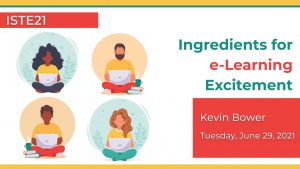Ingredients for e-Learning Excitement
Tuesday, June 29, 2021 ⬥ 12:30 – 1:15 PM EDT US
Presented by Kevin Bower
Session Description:
Join Chef Bower in the Creativity Kitchen to learn how to mix the right ingredients for engaging e-learning experiences. Thoughtful selection, organization, and specification of optimal learning experiences are necessary for your students to absorb, do, and connect with your curriculum.
Purpose:
William Arthur Ward stated, “The mediocre teacher tells. The good teacher explains. The superior teacher demonstrates. The great teacher inspires.” The purpose of this session is to inspire teachers to create e-learning experiences that engage and empower their students.
We have the resources and potential to bring medieval classroom practices into the 21st century. Like face-to-face classrooms, virtual learning experiences depend on knowledge objects and artifacts, mainly textbooks and readings, to present course content. However, advances in online tools allow you to recreate and improve the physical classroom’s structure and learning experiences. Well-designed virtual classrooms preserve the orderly structure and rich interaction of the face-to-face classroom while removing the requirement for everyone to be in the same location simultaneously.
Effective e-learning depends upon sound instructional design. Whether the setting is learner-centered constructivist or teacher-centered didactic, the design requires thoughtful selection, organization, and specification of optimal experiences for learning. Drafting lesson plans is a writing routine that dates back to 1921. It was believed that lesson planning would build teachers’ confidence and stimulate inquiry.
The following information is quoted from Horton (2012) in his description of the three types of activities. These activities are the main ingredients to engage e-learners. Tech tools will be available on the resource page linked below to support each category.
Absorb activities—Absorb activities, inform, and inspire. Absorb activities enable motivated learners to obtain crucial, up-to-date information they need to do their jobs or to further their learning. In Absorb activities, learners read, listen, and watch. These activities may sound passive, but they can be an active component of learning. For example, the students can absorb the content through a site like Edpuzzle to interact with the content.
Do activities—If Absorb activities are the nouns, then Do activities are the verbs of learning. They put people in action. They elevate learning from passive reading and watching to active seeking, selecting, and creating knowledge. Doing begets learning. The students could create slideshows using MySimpleShow or trading cards on BigHugeLabs to demonstrate their knowledge of the learning objectives.
Connect activities—Connect activities help learners close the gap between learning and the rest of their lives. They prepare learners to apply learning in situations they encounter at work, in later learning efforts, and in their personal lives. If Absorb activities are the nouns and Do activities the verbs, then Connect activities are the conjunctions of learning. The students could connect through a Padlet to further the discussion and engage in other social learning-type activities.
Objectives:
-
- Discuss strategies to inspire teachers to create e-learning experiences that engage and empower their students;
- Share strategies for absorb, do, and connect experiences that impact the students’ online learning; and
- Explore tech tools for absorb, do, and connect experiences to enhance learning goals.
Session Slide Deck:
